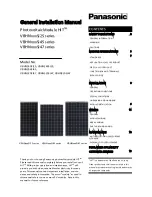
2
SAFETY PRECAUTIONS
All instructions should be read and
understood before attempting to
install, wire, operate, and maintain
the module.
The installation of modules requires
a great degree of skill and should
only be performed by qualified li-
censed professionals, including,
without limitation, licensed contrac-
tors and licensed electricians.
The installer assumes the risk of all
injury that might occur during instal-
lation, including, without limitation,
the risk of electric shock.
Before installing modules, contact
the appropriate authorities to deter-
mine permissions, installation and
inspection requirements, which
should be followed.
Be sure that the construction or
structure (roof, etc.) where the
modules are being installed has
enough strength.
Both roof construction and module
installation design have an effect on
the fire resistance of a building.
Improper installation may contrib-
ute to fire hazards. Additional de-
vices such as ground fault, fuses,
and disconnects may be required.
For a non-integral module or panel,
the assembly is to be mounted over
a fire resistant roof covering rated
for the application.
For modules mounted on roofs,
special construction or structures
may be required to help provide
proper installation support.
Do not install the module where
flammable gases or vapors are pre-
sent.
Do not use modules of different
specifications in the same system.
Follow all safety precautions of
other system components used.
In some areas, local electrical codes
may govern the installation and use
of modules.
WARNING
To avoid the hazard of electric shock,
sparks, fire and injury
The modules generate DC electrical
energy when exposed to sunlight or
other light sources, so cover the
entire front surface of the modules
with a dense, opaque material such
as a cardboard box, during installa-
tion and handling of the modules.
The shock hazard increases as mod-
ules are connected in parallel, pro-
ducing higher current, and as mod-
ules are connected in series, produc-
ing higher voltages.
The shock hazard increases as mod-
ules with nominal open-circuit volt-
age (Voc) in excess of 45 V, and/or
modules rated for maximum system
voltage in excess of 45 V.
Wear suitable clothing, gloves and
guards to prevent from direct con-
tact with 30 VDC or greater.
Work only in dry conditions, with
dry modules and dry tools.
Children and unauthorized persons
should not be allowed near the
installation of modules.
Do not puncture or damage the
back sheet of a module. Do not use
the PV module and make a replace-
ment, when scratch exposing con-
ductive part is found on the back
sheet.
Do not disassemble the module, or
remove any parts installed by the
manufacturer.
Do not open a junction box's lid.
Do not touch the junction box termi-
nals.
Do not change the wiring of bypass
diodes.
Do not connect or disconnect termi-
nals while modules generate elec-
tricity and connect electrical load.
Never leave a module unsupported
or unsecured.
CAUTIONS
To avoid the hazard of injury, burn and
damage to the module
Use a module for its intended pur-
pose only.
Be sure that all other system compo-
nents are compatible, and they do
not subject the module to mechani-
cal or electrical hazards.
Do not artificially concentrate sun-
light on a module.
Do not stand or step on a module.
When carrying a module, two or
more people should carry it by its
frame and wear non-slip gloves.
Do not carry a module by its wires or
junction box.
Do not drop a module.
Do not drop anything on the surface
of a module.
Do not hit the back sheet of a mod-
ule by the connector or other
things.
Do not disassemble a module, at-
tempt any repair, open the junction
box cover, nor remove any parts
installed by Panasonic. There are no
user serviceable parts within the
module or junction box.
Do not treat the back sheet or front
surface with paint or adhesives.
Do not use or install broken mod-
ules. If you find a breakdown such
as glass breakage, contact the pro-
fessional installer to replace it
promptly.
Do not touch a module unnecessari-
ly. The glass surface and frames get
hot.































